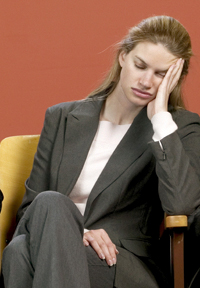
Getting the right amount of sleep is vital, but just as important is the quality of your sleep. Biological conditions unique to women, like the menstrual cycle, pregnancy and menopause, can affect how well a woman sleeps. This is because of the changing levels of hormones that a woman experiences throughout the month and over her lifetime. Estrogen and progesterone have an impact on sleep, and understanding the effect of these hormones, environmental factors and lifestyle habits can help women enjoy a good night’s sleep.
The Most Common Sleep Problems in Women
Insomnia
Insomnia is a symptom, not a disorder in itself. If you experience difficulty falling asleep, staying asleep or enjoying a restful night’s slumber, you’re suffering from insomnia. It’s a common symptom in the U.S., reported by nearly half of Americans surveyed in a 1995 National Sleep Foundation (Sleep in America) Gallup Poll. Insomnia may last for a day (transient), weeks (short-term) or months (chronic). Some think that the longer insomnia lasts, the harder it becomes to treat. If you suffer from insomnia that lasts for more than a few days, you should consult your physician. The underlying cause should be identified, if possible, and then treated. Unfortunately, this is not always possible. Chronic insomnia will probably require longer-term treatment than other types. Sleep medication is generally considered a short-term solution. Insomnia can be caused by many factors including:
- Stress
- Depression
- Anxiety
- Physical illness including Restless Legs Syndrome (RLS)
- Caffeine intake
- Irregular schedules
- Circadian rhythm disorders
- Drugs (including alcohol and nicotine)
- Occasional or chronic pain.
Insomnia may be secondary to other disorders as well, such as RLS or an advanced sleep phase disorder. These sleep disorders are more common in the elderly too. Moreover, they increase in frequency as we enter middle age.
Sleep Apnea
Sleep apnea is a serious sleep disorder that is characterized by snoring, interrupted breathing during sleep and excessive daytime sleepiness. While apnea is more common in men, it increases in women after age 50. Menopausal women are three-and-a-half times as likely to get this sleep disorder. Studies have also found that sleep apnea is associated with increased blood pressure, a risk for cardiovascular disease and stroke.
Restless Legs Syndrome (RLS) and Periodic Limb Movement Disorder (PLMD)
RLS sufferers have difficulty sleeping because the unpleasant feelings associated with the syndrome occur at rest and are only relieved by movement. Due to difficulties sleeping, RLS can lead to daytime sleepiness, mood swings, anxiety and depression. About 80 percent of those with RLS also have PLMD or involuntary leg twitching and jerking movements during sleep that can occur every 20-30 seconds.
Narcolepsy
Narcolepsy is a chronic neurological disorder that affects approximately one in 2000 people. Symptoms frequently appear in teen years. In addition to excessive daytime sleepiness, people with narcolepsy have sudden “sleep attacks” (an over whelming urge to sleep), suddenly lose muscle tone or strength and may have disturbed nighttime sleep.
Nocturnal Sleep-Related Eating Disorder
People with nocturnal sleep-related eating disorder (NS-RED), an uncommon condition, eat food during the night while they appear asleep. Since parts of the brain that control memory are asleep, people with NS-RED cannot remember nighttime eating. One study indicates that over 66 percent of sufferers are women. It can be caused by medications—some drugs prescribed for depression or insomnia—and by sleep disorders—sleep apnea and restless legs syndrome can cause awakenings and trigger sleep eating.
Healthy Sleep Tips
The following 10 tips can help you achieve sleep and the benefits it provides. These tips are intended for “typical” adults, but not necessarily for children or persons experiencing medical problems.
- Maintain a regular bed and wake time schedule, including on the weekends.
- Establish a regular, relaxing bedtime routine such as soaking in a hot bath or hot tub and then reading a book or listening to soothing music.
- Create a sleep-conducive environment that is dark, quiet, comfortable and cool.
- Sleep on a comfortable mattress and pillow.
- Use your bedroom only for sleeping or intimacy.
- Finish eating at least two-three hours before your regular bedtime.
- Exercise regularly. It is best to complete your workout at least a few hours before bedtime.
- Avoid caffeine—including coffee, tea, soft drinks and chocolate—close to bedtime. It can keep you awake.
- Avoid nicotine—cigarettes and other tobacco products. If used close to bedtime, it can lead to poor sleep.
- Avoid alcohol close to bedtime.
What to Do if You Have Sleep Problems
Keep a sleep diary and talk to your doctor. Try these 10 tips and record your sleep and sleep-related activities in a sleep diary. If problems continue, discuss the sleep diary with your doctor. There may be an underlying cause and you will want to be properly diagnosed. Your doctor will help treat the problem or may refer you to a sleep specialist. TPW
